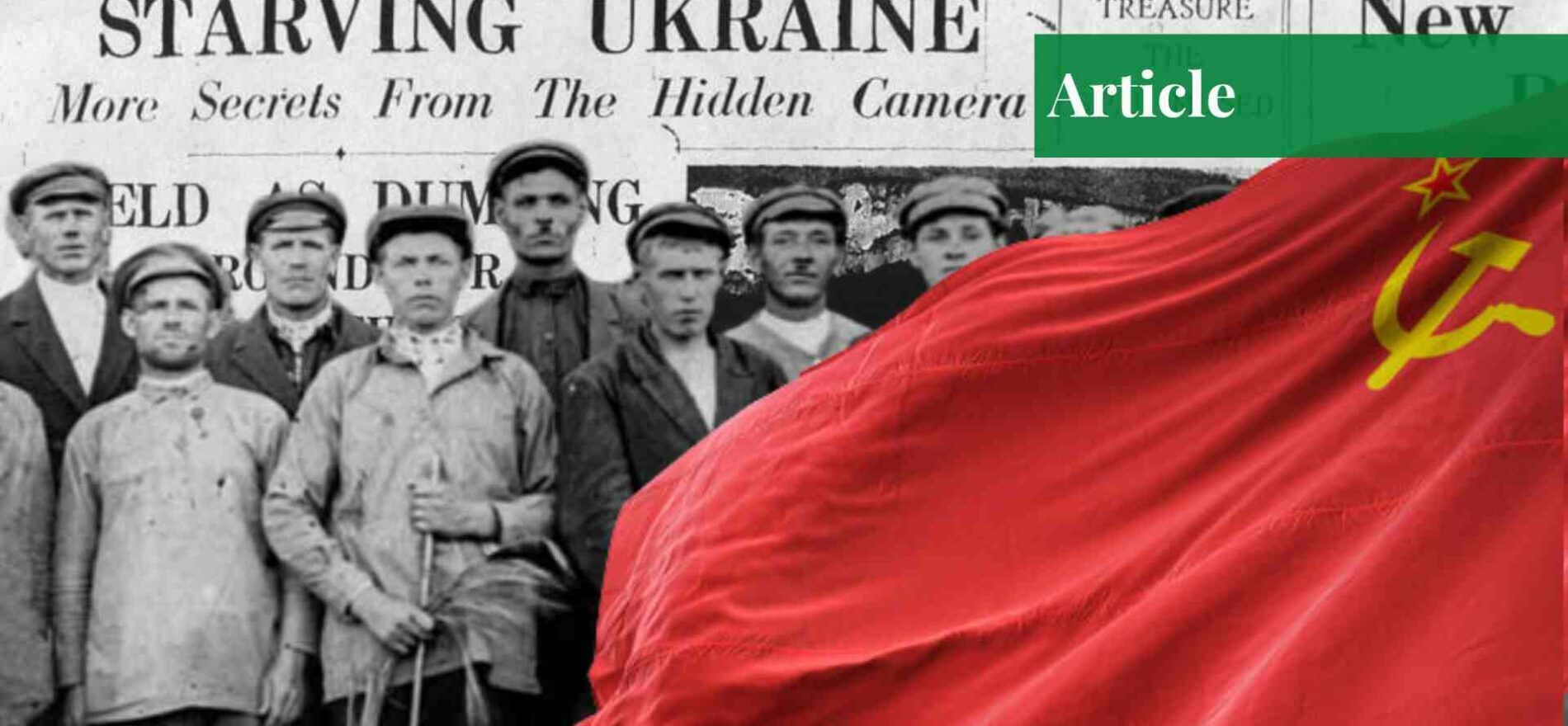Background
Before WWI, Ukraine was just a part of the larger Russian empire. However, in 1917, after the collapse of the Russian empire, Ukraine gained freedom, declaring itself the independent Ukrainian People’s Republic. This independence turned out to be quite brief as by 1922, Ukraine got forcefully integrated into the newly formed Soviet Union, and Ukraine became known as the ‘Ukrainian Soviet Socialist Republic’.
At that time, Ukraine was largely rural and was known for its farmlands. The population largely constituted villagers and farmers whose livelihoods depended on the farming and cultivation of the land that they owned. With one of the world’s most fertile soil, the country was among the largest grain-producing states in the USSR. Therefore, it gained recognition as the “breadbasket of the Soviet Union”.
Causes
Ukraine had a history of opposition and resistance to the Soviet Union, and so was a major threat to the Stalin regime. Moreover, the Ukrainization that took place in the 1920s further strengthened Ukraine’s cultural autonomy. These factors gave rise to the fear of the secession of Ukraine from the Soviet Union, which prompted Joseph Stalin, then premier of the Soviet Union, to take measures that ultimately resulted in the most terrible famine in the country’s history.
To prevent the “Ukrainian national counterrevolution” which the Stalin government saw as an ideological threat to the Soviet Union, it resorted to large-scale mass repressions and crackdowns. The supporters of pro-Ukrainian policies, be they Ukrainian intellectuals, church leaders, or members of the Ukrainian Communist Party, were arrested, imprisoned, and executed to curtail Ukraine’s cultural autonomy.
Similarly, the goal to gain complete control of the “breadbasket of the Soviet Union” made Stalin introduce the First Five-Year Plan in 1928. Another objective of this Five-Year plan was to industrialize the entire Soviet Union at a rapid pace which meant building up industries like electricity, steel, and coal. To fund this project of transforming the USSR into an industrial power, Stalin turned to the “collectivization” of agriculture.
This collectivization focused on confiscating the private property of independent farmers and consolidating individual farms across the Soviet Union into large, state-run farms. The collectivization made it easier for the Stalin government to extract surplus grain produced by the farms which in turn gave them direct control over Ukraine’s rich agricultural resources including grain production, its supply, and export.
Consequently, many Ukrainians, who were small-scale or subsistence farmers and had worked independently for their entire lives, resisted Stalin’s plan and collectivization. Over 4,000 local rebellions were recorded against Stalin’s policies, which were suppressed by the Red Army and the Soviet secret police. In addition to this, Stalin also responded by making use of propaganda campaigns.
Those who opposed Stalin’s policy of collectivization were labeled as ‘kurkuls’, a Russian term for the wealthy peasant. They were depicted as greedy, exploiters, and enemies of the state and their belongings were seized by the government. The elimination of these so-called Kulaks was a crucial part of collectivization as hundreds of thousands of them were exiled, imprisoned, or executed. This destruction of Ukrainian rural life through the various policies of Stalin, most importantly that of collectivization, set the stage for the Holodomor, which shook the entire Ukraine.
The Terror Famine
In 1932, the Communist government set extremely high grain procurement quotas that were far beyond the capacity of the farmers across the USSR. When farmers failed to meet the quota, Stalin’s men swept their farms to confiscate all the grains they could find. Records show the Soviets took over 4.27 million tons of grain from Ukraine alone in 1932. That same year, a new law punished anyone who even took a handful of grain or was caught hiding grain or bread with 10 years in prison or the death penalty for stealing “socialist property”. Thus, about 54,645 people were imprisoned; of those, 2,000 were executed.
Stalin’s oppressive collection policy resulted in a famine that started spreading in grain-producing regions across the USSR. Some party members sent Stalin letters about the growing crisis pleading for a policy change. However, instead of reversing its policies, the Stalin government doubled them down. The government’s adherence to collectivization had deadly impacts all over the Soviet Union, but in Ukraine, the impacts of the famine aggravated due to Stalin’s fear of Ukrainization.
In the fall and winter of 1932, Soviet police began seizing not just grain but anything edible, even livestock. The farms and over one-third of the villages in Ukraine were blacklisted for missing grain quotas, torn apart for food, and prohibited from receiving any supplies. In January 1933, to stop Ukrainians from leaving Ukraine in search of food, Stalin seized the borders of Ukraine. Moreover, the migration from Ukrainian villages to cities was also policed by initiating a system of internal passports.
In the coming months, tens of thousands of Ukrainian villagers were caught trying to flee and were sent back to their homes to starve. To escape death by starvation, people began to catch birds, mice, dogs, cats, and just anything that could give them some sort of sustenance. The desperation of people was evident from the fact that they began eating the flesh of the animals and some even resorted to cannibalism.
After May and June of 1933, the impacts of famine began to alleviate as the labor force debilitated, prompting the Stalin government to take measures to decrease grain confiscations and massive arrests of farmers. Holodomor perished millions of people so the government had to send people from other parts of the Soviet Union over to Ukraine. Several resettlement programs had to be initiated to rebuild the country’s labor force.
As far as the death toll is concerned, the exact number of victims remains unknown. However, various estimates have been made, even though many deaths remained unregistered. As per the most recent study conducted by a team of demographers from Ukraine, around 3.9 million Ukrainians lost their lives in Holodomor. Other areas that constituted a large number of the Ukrainian population like the North Caucasus also suffered greatly.
The Holodomor as Genocide
The majority of historians have deduced the Holodomor as man-made, engineered by the Stalin government, to subjugate the Ukrainians. It is evident from the factors that gave rise to famine and the fact that even at the start of 1933, the USSR had enough grain reserves to feed well over 10 million people. Moreover, the Stalin government refrained from organizing famine relief or accepting any foreign aid. Instead, the government exported Ukraine’s grain and other food abroad for cash, while the people in Ukraine starved.
However, the debate on whether the Holodomor can be termed genocide or not continues to rise among scholars as they hold diverse views and opinions. Raphael Lemkin (1900-1959), a Polish lawyer, known for coining the term ‘genocide’, declared Holodomor “the classic example of Soviet genocide.” According to the United Nations Convention on the Prevention and Punishment of Genocide, formed on the basis of Lemkin’s ideas, genocide has been defined as acts “having the intent to destroy, in whole or in part, a national, ethnic, racial or religious group, as such.”
Lemkin applied this definition to Holodomor’s case and proved that it was a genocide aimed to crush the Ukrainian nation. Lemkin’s application of genocide to the Holodomor in Ukraine was based on four reasons. The first one was the extermination of intellectuals. In Stalin’s era, millions of Ukrainian writers, artists, thinkers, teachers, and politicians were beheaded, imprisoned, or deported. Moreover, around 75% of the Ukrainian intellectuals and professionals were brutally exterminated by the Soviet regime.
The second reason was the destruction of churches and priests. Between 1926 and 1932, around 10, 000 clergy died. Thirdly, the starvation of farmers was also a major reason to declare this famine a genocide. Stalin’s Five-Year Plan and the policy of collectivization were deliberately devised in a way that led to the massive starvation of farmers. Lastly, the disintegration of Ukrainians through resettlement also made Lemkin categorize this famine as genocide. To destroy their ethnic unity, the Ukrainians were dispersed throughout Eastern Europe.
Stalin’s policies served as a plan for the systematic destruction of the Ukrainians as a nation. The severe decrease in the Ukrainian population is evident from the fact that the Ukrainian population reduced from 23.2 million to 19.6 million in the face of the Holodomor. Lemkin’s ideas regarding the Holodomor as genocide were shared by several other leading scholars and historians like Robert Conquest, Anne Applebaum, Timothy Snyder, Norman Naimark, and James Mace.
Holodomor Denial
In Russia, Stalin carried out a major propaganda campaign to conceal the impacts and devastation of this planned famine. During the famine, Stalin blatantly rejected the notion that a famine ever took place by declaring the reports of starvation an exaggeration. Not only did he prohibit the Soviet press from covering the Holodomor but he also banned the entry of foreign correspondents into Ukraine.
Stalin intentionally allowed the use of words like “food shortages” or “food supply problems” instead of famine, as it would help to understate the Holodomor and its impacts. For example, Walter Duranty, a popular American journalist who wrote extensively on the success of Stalin’s policies and even won a Pulitzer, denied the existence of Holodomor in his accounts, calling it a “food shortage”.
Many journalists disagreed with Duranty and wrote about the chaos and destruction caused by famine. One such journalist was Gareth Jones, who wrote several articles on how “famine ruled Russia”. In response, Duranty put on another article insisting that “Russians were hungry, but not starving”. Scholars like Robert Davies, Stephen Kotkin, Stephen Wheatcroft, and J. Arch Getty rejected the idea that the Holodomor was planned by Stalin. Rather, they declared it as a by-product of the unintentionally bad policies of Stalin’s government and the lack of adequate information regarding the problem.
Apart from media manipulation, chronicles were also destroyed, and the use of the word “starvation” in death certificates as the cause of death was restricted by the Stalin government. Similarly, Stalin refrained from making the report of the 1937 census public as it showed a significant decline in the Ukrainian population. In the decades that followed, the Soviet Union continued to suppress the Holodomor.
Holodomor in Modern Politics
In 2003, at the United Nations, 25 countries recognized the Holodomor and declared that it caused the death of 7 million to 10 million lives. Holodomor was not only recognized as genocide in Ukraine but the country’s parliament also criminalized its denial in 2006. The Holodomor is quite significant as it provides the details of oppression in a multi-ethnic society, under the rule of a dictator. The relevance of the Holodomor has further increased in the present era with the Russian invasion of Ukraine, but this time, Ukraine has no plans to bear genocide and is ready to show resistance with the help of the West’s support.
If you want to submit your articles and/or research papers, please check the Submissions page.
The views and opinions expressed in this article/paper are the author’s own and do not necessarily reflect the editorial position of Paradigm Shift.














